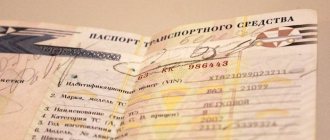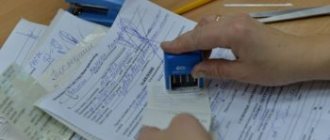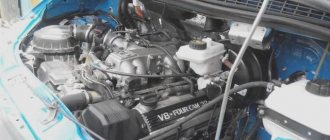What is PTS, and how to recognize a fake? Let's figure it out together.
A vehicle passport is a document in which you will find the technical characteristics of the vehicle, learn about its owners and see the history of registration and deregistration with the traffic police.
The document does not need to be updated when changing your registration or surname. It has no expiration date and is transferred to the new owner along with the keys.
If, when buying a car, you doubt the seller’s honesty, be sure to check the registration certificate for authenticity. And do this before you take the car for diagnostics to avoid unnecessary costs.
Contents of the vehicle passport
The vehicle passport is a double-sided document in A4 format. It is assumed that the PTS will be folded in half and it will look like a little book:
The picture above shows the front side of a car passport .
The right side provides detailed information about the vehicle. This part is filled out by the organization that issues the vehicle passport: the manufacturer, customs authorities or traffic police authorities.
How many seats are there for owners in the PTS?
The left side of the form contains 2 large rectangles intended for entering the owners of the vehicle. Another 4 similar rectangles are contained on the back of the PTS, i.e. The maximum number of owners in the PTS is 6 . If a car often changes owners and the free space has run out, then the current owner must contact the traffic police to replace the title.
Replacing a vehicle passport
The series and PTS number are indicated on the front side of the document in two places: at the top of the right column and in the middle of the left column. The series and number are printed in red, so they are immediately noticeable.
Often, the car owner cannot find the date of issue of the PTS. It is located in the lower right part of the front side of the form, in field number 25 (next to the seal).
A few words about the passport form .
This document has a high degree of security; on the front and back there are holograms with very fine details. The background of the document also contains numerous patterns. However, PTS are often counterfeited and below I will talk about how to check the document before buying a car.
What is a PTS car and why is it needed?
Any vehicle, like a person, has a “personal” document that identifies it by individual characteristics.
The PTS car document, the decoding of which sounds like a vehicle passport, is one of the mandatory documents that every car owner must have. This contains detailed information about the vehicle, the current owner and former owners of the vehicle.
The need to use this document, according to the legislation of the Russian Federation, is due to the following purposes:
- simplification of control over the admission of vehicles to use within the Russian Federation;
- improving the process of regulating customs duties;
- regulation of relationships between entities on the country's roads.
Also, the use of the document helps reduce the number of offenses and helps combat criminal activity.
The car owner will need a vehicle title in the following situations:
- Confirmation of ownership of a vehicle.
- Carrying out registration actions, for example, when registering a car with state registration.
- Concluding a vehicle purchase and sale transaction.
The document is issued for all vehicles with an engine capacity equal to or greater than 50 cm3.
Duplicate and original PTS
The original PTS is a document issued by the manufacturer or customs authorities (when importing a car from another state).
A duplicate PTS is a document issued by the traffic police to replace a lost one or a passport that has run out of space. At the same time, there is a very big difference between the listed options from the point of view of the car buyer.
To distinguish the original from a duplicate, you need to check who issued the document. To do this, look in the lower right corner of the passport and find field 23 “Name of the organization that issued the passport.” If the traffic police department is indicated in this field, then you have a duplicate. You can also pay attention to the seal of the organization. The stamp of the State Traffic Inspectorate is placed on the duplicate.
If in the lower right corner the data of the manufacturer or customs organization is indicated, as well as their stamps, then this is the original.
If you are holding a duplicate PTS in your hands, then pay attention to the special marks on the right side of the front side of the PTS. There may be the following information:
- The PTS was issued to replace the scrapped one . This means that the previous PTS ran out of space and the owner replaced it with a new one at the traffic police. At the same time, the old passport was handed over to the traffic police officers.
- The PTS was issued to replace the lost one . This means that the old passport was not handed over to the traffic police, i.e. The PTS was issued to replace the lost one. When buying a car, you need to pay special attention to this option.
Let's look at what this or that version of PTS threatens us with when buying a car on the secondary market:
- The original is the best option, you can view all previous owners.
- A duplicate that was issued a long time ago and already has several owners. Also a good option. It means that the traffic police previously had no problems with this PTS.
- A duplicate to replace the scrapped vehicle title, which was issued recently. This is a normal option, because... sooner or later the place in the PTS may run out.
- A duplicate to replace the lost PTS, which was issued recently. This option is not recommended. On the one hand, this type of passport may appear, for example, if the car owner’s documents were destroyed by fire. On the other hand, various criminal schemes may be hidden behind it.
Let's look at a few examples.
1. A duplicate can be obtained in order to hide the previous owners of the car, one of which is the insurance company. This means that the car for sale was previously involved in an accident, where it received very serious damage and could not be restored. The insurance company paid compensation to the owner and took the car for itself. After this, the car was bought by a reseller and hastily restored. To hide information about an accident, the reseller “loses” the title and receives a new one from the traffic police.
2. A duplicate can also be obtained if the original serves as collateral. For example, a PTS may be stored in a bank where the previous owner did not repay the loan. There may be other property disputes. For example, a married couple is going through a divorce. At the same time, the title remains with the wife, but the husband actually uses the car. The husband can get a duplicate title and sell the car secretly from his wife.
In general, buying a car that has recently been issued a duplicate title is highly not recommended. As for the other options, they also do not guarantee an ideal vehicle history. Nevertheless, the likelihood of encountering problems is greatest in the case of a duplicate issued to replace a recently lost title. There is no point in buying a car with such documents.
Vehicle chassis. Difficulties with registration
The chassis is the basis for the production of a vehicle, the chassis itself is not a vehicle! Do you need a chassis? We are ready to offer you chassis from stock. To clarify the cost, you need a written application on your organization’s letterhead signed by the manager. Before purchasing a chassis, we suggest that you read the following information.
So, you have decided to purchase a vehicle chassis to manufacture special equipment yourself. A few facts to consider when purchasing a chassis:
| 1. A PShTS is issued on the vehicle chassis . PShTS (vehicle chassis passport) is a document containing information about the main technical characteristics of the vehicle, identification data of the main units, and information about the owner. It is the main document confirming the buyer’s ownership of the chassis. The vehicle chassis cannot be registered with the registration authorities of the State Traffic Safety Inspectorate. It is prohibited to travel on public roads on the chassis; it cannot be operated as an independent vehicle. | |
| 2. For finished vehicles, a PTS is issued instead of a PShTS. To obtain a PTS, the owner of the vehicle chassis must have a valid OTTS certificate . PTS (vehicle passport) is a document containing information about the main technical characteristics of the vehicle, identification data of the main units, information about the owner, registration and deregistration. The vehicle identification number (VIN), make, model, name and category of the vehicle, year of manufacture, engine model and number, chassis and body numbers, body color, power and displacement and type of engine, permissible maximum weight, unloaded weight are indicated in the vehicle title. , as well as information about the manufacturer, country of export and customs restrictions. The PTS is issued by the selling company (representative of the manufacturer) upon the first sale of the vehicle. | |
| OTTS (vehicle type approval) is a certificate that allows the production of new vehicles in the Russian Federation. This document confirms the safety of the new vehicle (vehicle) within the framework of the technical regulations of the Russian Federation “On the safety of wheeled vehicles” and “On the requirements for emissions from automotive vehicles ... of harmful pollutants” (until December 31, 2014), as well as the technical regulations of the Customs Union “On the safety of wheeled vehicles” (from 01/01/2015). Vehicle type approval is issued by product certification bodies accredited in the prescribed manner. To obtain a Type Approval, documents are required confirming the ability to identify vehicles, proving compliance of vehicles with technical requirements, as well as information about the presence of a Quality Management System at the vehicle manufacturer. Availability of Vehicle Type Approval (OTTS) guarantees the integrity of the manufacturer . |
3. To manufacture a complete vehicle, it is necessary to obtain a Chassis Approval Protocol from the chassis manufacturer . To draw up a protocol for permission to use, you must:
- provide an Explanatory Note, including: information about the basic configuration of the vehicle (chassis), modifications made and connections to its systems; weight distribution of the product equipped and full (taking into account cargo and crew) masses with distribution on the front axle (axle) and on the rear axle (trolley); height of the center of gravity; power take-off (torque) indicating in the kinematic diagram the shaft rotation speeds and the model of the power take-off (PTO); information about the minimum and maximum speed of the product; information about the power of electricity consumers and their operating modes; dimensional diagram of the product (left view, A4 format). Details of the developer and manufacturer of the product, incl. a copy of the certificate of assignment of the international vehicle manufacturer identification code (WMI), address (legal, postal, location); Full name of the director and chief designer;
- provide the following documentation: technical specifications (TS) and operating instructions (OM), as they relate to the vehicle (chassis), incl. purpose, weight parameters (curb and gross weight with weight distribution, weight and volume of transported cargo, number of people in the transported crew, total weight of the trailer and road train, for a truck tractor - weight per fifth-wheel coupling device and semi-trailer bogie, total weight of the semi-trailer, indicate in the technical specifications - the location of the manufacturer's plate, an example of the VIN code designation and its location, in the manual - the procedure for turning on the PTO); assembly drawing of the product (side view, left in transport position) indicating the wheelbase, dimensions from the axis of the front wheels to the beginning of the superstructure and its length, rear overhang of the chassis frame, method of attaching the superstructure to the chassis frame (car platform) or a separate drawing for installing the superstructure ( in the front part of the superstructure fastening, it is recommended to introduce elastic elements, in the rear part of the fixing angle or plate) with a specification including, incl. position of the vehicle (chassis), installation of superstructure, electrical equipment, installation of PTO, modifications; drawing (diagram) of the installation of lighting equipment (side lights, contour lights and tail lights, flashing beacons, additional headlights, etc.); drawing (diagram) of the PTO installation; drawings of modifications to the car (chassis); diagrams for the selection of compressed air and electricity (taking into account side and contour lights, PTO control, etc.) indicating the location of connection to the chassis and a list of elements of electricity consumers. All documents must be approved.
- After manufacturing a special vehicle, it is necessary to submit: a protocol for weighing the product with curb and total (including crew and cargo) weights; photograph of the product, color - side view.
| 4. If you purchase a vehicle chassis with a title . When manufacturing special equipment on a vehicle chassis with a title, as a rule, registration of re-equipment and modifications to the design of the vehicle are required. Registration of re-equipment and modifications to the design of the vehicle is carried out only by the owner of the vehicle. When purchasing a chassis with a title, you automatically become the owner of the vehicle and from that moment all actions related to the conversion, incl. paperwork falls on your shoulders. |
To complete the conversion, the vehicle owner must:
- register the vehicle;
- obtain from the traffic police department of the Ministry of Internal Affairs of the Russian Federation at the place of registration of the vehicle the form - “Application for making changes to the design of a vehicle” (Appendix No. 1 to the “Procedure for monitoring changes to the design of vehicles registered with the State Traffic Safety Inspectorate of the Ministry of Internal Affairs of the Russian Federation”, order of the Ministry of Internal Affairs of Russia dated 7 December 2000 No. 1240), fill it out and send it to the traffic police department;
- Based on the results of consideration of the application, the State Traffic Safety Inspectorate of the Ministry of Internal Affairs of the Russian Federation makes a decision (with a signature and seal), which specifies the procedure and conditions for registration and issuance of a “Certificate of approval of the design of the vehicle to safety requirements” (the final document that provides the converted car with the “right to life”) ;
- if the decision provides for obtaining an “Opinion on the possibility and procedure for making changes to the design of the vehicle,” then the owner of the vehicle applies to the certification body for the issuance of an Opinion;
- the organization that has carried out the work to make changes to the design of the vehicle draws up and submits to the owner of the vehicle “Application - declaration on the volume and quality of work to make changes to the design of the vehicle” (Appendix No. 3 to the “Procedure for control over changes to the design of vehicles registered in the State Traffic Safety Inspectorate of the Ministry of Internal Affairs of the Russian Federation,” order of the Ministry of Internal Affairs of Russia dated December 7, 2000 No. 1240), as well as a certified copy of the Certificate of Compliance for the performance of these types of work;
- after making changes, the technical condition and design of the vehicle is checked for compliance with the requirements of regulatory and legal acts in the field of ensuring road safety at the State Traffic Safety Inspectorate or VET (in the direction of the State Traffic Safety Inspectorate in accordance with the decision on the application of clause 3) with the execution of a diagnostic card, which is issued in hand owner of the vehicle;
- then the owner of the vehicle submits the completed documents to the traffic police department of the Ministry of Internal Affairs of the Russian Federation at the place of registration for registration of the “Certificate of approval of the design of the vehicle to safety requirements.”
As a result, in order to obtain a “Certificate of approval of the design of a vehicle to safety requirements,” the owner of the vehicle must submit the following documents to the traffic police department of the Ministry of Internal Affairs of the Russian Federation ( when making changes to the design of a registered vehicle):
- Identity document.
- A document confirming the right to own or use and (or) dispose of a vehicle.
- Vehicle passport and vehicle registration certificate (technical passport, technical coupon).
- Application to the traffic police and decision on it.
- Conclusion of the authorized organization on the possibility and procedure for making changes to the design of the vehicle.
- Draft Application - declaration and a copy of the Certificate of Compliance for Maintenance and R of the Organization that will perform the work.
- Diagnostic card (OTOR).
- Copies of Certificates of Conformity for installed products, units (if they are subject to mandatory certification) and permits from Gostekhnadzor, Kotlonadzor, Ministry of Health and other organizations, if they are subject to registration (automotive cranes, auto-hydraulic lifts, pressure tanks, etc.).
If you are aware of all the risks associated with purchasing a chassis, and are sure that you will not have problems obtaining a title and completing the conversion, then we are waiting for your application. In the application, you must indicate the type of vehicle planned to be manufactured on the chassis, and at which enterprise you plan to carry out the conversion.
How to restore a lost PTS?
Let's look at the situation from the other side - through the eyes of the seller. If the PTS is truly lost, then it should be restored. In this case, the procedure is completely similar to replacing a passport:
Replacing PTS
To restore a lost PTS you will need the following documents:
- Statement.
- Car owner's passport.
- Old registration certificate, if it is not lost along with the PTS.
In addition, there must also be:
- OSAGO insurance has been issued (it is not necessary to provide a policy);
- state fees have been paid for issuing a PTS and a new registration certificate (800 + 500 rubles).
You should contact any registration department of the traffic police with the above documents.
However, I would like to remind you once again about the information given above. If you restore the title to replace the lost one, then savvy buyers will avoid the car. So, before receiving a duplicate, try to find the original PTS. Check all possible places where your passport could have been lost.
If you still cannot find the document, you will have to restore it to the traffic police. At the same time, there is an opportunity to reduce the negative effect for car buyers. A photocopy of the original PTS, made in advance, will help you with this. In general, you need to make a copy immediately after purchasing a car, but if you still don’t have one, then make a copy without delay . Most likely it will not be useful, but it is better to take this point into account.
When you meet a potential buyer, show him a duplicate PTS and a photocopy of the original, and then offer to check the car’s registration history on the official website of the traffic police. The buyer will be able to see that the information in the photocopy matches the information in the police database. Confirmed data from previous owners will help resolve some of the questions.
How to find out online
It is not possible to find out online the date of issue of the PTS using other details (number and information about the organization that issued the document).
However, the following information can be obtained from traffic police databases:
- about the presence/absence of unpaid fines by the car owner;
- about the number of owners and dates of re-registration of the car. Finding out the history of registration actions is especially important if, when purchasing a vehicle, the owner provides not the original, but a duplicate document;
- about the participation of this vehicle in road accidents and damage received;
- about the car being wanted;
- about the presence/absence of restrictions on registration actions imposed by the bailiff service, for example, in case of failure to pay taxes by the car owner;
- on the presence of vehicles as collateral with a bank or other company (private individual) in accordance with a loan agreement or other circumstances;
- about the availability of a compulsory car insurance policy and its validity period.
This information will be useful to the buyer when purchasing a used vehicle to completely exclude the fact of fraudulent activities or the provision of false information by the car owner.
How to check? To obtain data you need:
- go to the traffic police website and go to the “Services” section;
- select the “Vehicle check” option;
- Enter the required data in the form that opens. It is more expedient to check using an individual VIN number, but you can also use chassis or body numbers;
- select one or more of the proposed checks and click on the “Request check” button.
If a car is purchased using a duplicate vehicle passport, it is important to additionally check the document for originality. To do this, you can use the FINformer website.
The proposed form indicates:
- the first three characters of the vehicle identification number. If the car is not serial, then you additionally need to enter a code;
- the organization that issued the PTS;
- Document Number;
- the region in which the PTS was issued to the owner of the vehicle;
- date of issue of the document.
As a result of the check, you can find out:
- is the document with the specified details listed in the database of stolen forms;
- whether the document is an original or a duplicate;
- Do the data specified in the PTS match the real information?
Any verification system is confidential and can be carried out solely for personal purposes.
You can also obtain the necessary information at any traffic police department after providing a civil passport and PTS or a vehicle registration certificate.
However, obtaining data online is more in demand, as it reduces time and money costs.
Checking the title when buying a car
Above it was said that there are two versions of PTS: original and duplicate. However, there is another option that can also be found in practice - a fake PTS .
Buying a car with a fake passport can cause serious problems for the buyer. Most often, the matter ends with the fact that the car cannot be registered with the traffic police, because he is listed as stolen. After this, the car is either returned to its rightful owner, or left to the buyer for safekeeping until the owner shows up. In any case, the buyer is left without a car and without money.
Let's figure out how to identify a fake PTS in practice.
Visual inspection of the document
People who constantly deal with PTS can identify a fake from a distance of several meters. If you have never dealt with passports, I recommend using a sample.
Take the original PTS from any other car (relative, friend) and carefully compare both passports. In this case, you need to pay attention to both the quality of the form itself and the quality of the inscriptions applied. Use a magnifying glass to check thoroughly.
However, if you are not confident in your own abilities, use the second option.
Checking PTS at the traffic police post
In any case, this option is optimal. Together with the car seller, go to the nearest traffic police post and ask the traffic police officers to check the documents and run them through the databases; they will not refuse you. Traffic police officers constantly deal with car documents, so they can easily identify a fake.
In this case, another problem may arise. What to do if the seller refuses to go to the traffic police post? It's very simple, you should stop buying a car. A normal car owner has nothing to fear.
Description
What is a vehicle registration certificate? Every person should know the answer to this kind of question, because anyone can face the corresponding paper.
PTS is a document containing information about the car, its owners and manufacturer. The form in the established form indicates detailed characteristics and parameters of the transport, the history of the transfer of ownership of movable property, restrictions and encumbrances imposed on the car.
The technical passport plays a vital role after purchasing a vehicle. The absence of this paper creates many obstacles for further registration actions with the car.
How to fill out a title when selling a car?
Let's consider another important issue related to PTS. We are talking about adding a new owner after concluding a car purchase and sale agreement.
In fact, there is nothing complicated here. Select the following free rectangle to enter the new owner (the back side of the title is filled in first, then the front side) and enter the buyer’s data into it:
1. In the “Owner Full Name” field, write down the buyer’s last name, first name and country. The recording can be made with a ballpoint pen.
2. In the “Address” field, indicate the buyer’s place of registration, indicated in his passport.
3. In the “Date of sale” field, indicate the date the car was transferred to the new owner.
4. In the “Document of ownership” field, enter the name of the agreement. If the car is for sale, then write “purchase agreement”. If the car is being given as a gift, please enter the “deed of gift” entry.
5. In the “Signature of the previous owner” field, put your signature (signature of the seller).
6. The buyer must sign in the “Signature of the present owner” field.
There is no need to enter other data into the PTS; everything else will be filled out by traffic police officers when registering the vehicle.
Instructions for registration of PTS
Who issues a title for a car?
When purchasing a new or used car, the buyer must be provided with a title along with the vehicle. This PTS must already indicate the full name and other details of the new owner.
Where to get a vehicle registration certificate:
- receive and re-register in your name from the previous owner;
- get it from a car dealership dealer;
- obtain from the manufacturer;
- get it at customs (one of the divisions of the customs authority).
Here are all the options for obtaining PTS
All car owners who sold or donated their cars to someone must sign in the “special notes” column of the vehicle title as the previous owner.
By the way, many people are interested in how and where to draw up a car purchase and sale agreement (VSA). The purchase and sale agreement gives the right to drive the vehicle within 10 days. Now it can be drawn up by the buyer and seller independently, and signed without a notarized signature. In such a transaction, the previous owner of the car transfers the title of the car to the buyer along with the car.
If a car is purchased at a car dealership, and not necessarily new, the buyer is given a title by the dealership employees. Therefore, if they say, take the car, you will receive a title later, for example, in 2 weeks, in no case should you agree.
The peculiarity of buying at a car dealership is that even if you buy a new car, the title will indicate that the buyer is the second owner, and maybe even the third, etc. There is nothing to worry about here, since the manufacturer sold the vehicle to a dealer, and he either sells it directly to an individual or sells it to car dealerships.
Even if it is indicated that the second owner, the buyer who bought a new car is still considered the first owner until he sells it.
When selling new cars, the manufacturer (Russian) also transfers the title to the dealer. If the car was imported from abroad, then the PTS must be obtained at the border from the customs authorities. The procedure is the same for both new and used cars.
How to restore/fix/get a new copy
How to restore a registration certificate? This issue begins to worry citizens unexpectedly. And not everyone knows how to behave correctly to achieve the desired goal.
PTS restoration will be carried out as follows:
- Generate a package of certificates for re-issuance of PTS. We'll talk about it in more detail later.
- Write an application for the issuance of a new vehicle registration certificate.
- Go to your local police department and file a complaint about the loss or theft of your license. If the PTS is damaged, this step can be skipped.
- Submit a request for the issuance of a duplicate of the paper being studied to the registration authority.
- Carry out a technical inspection of the car. This step is not always required.
- Pay the state fee for registration of the car.
Now all that remains is to wait. After some time, the applicant will be issued a duplicate registration certificate. Together with it, the STS will be updated. This is a mandatory procedure.
Content
What kind of information can be seen in the PTS? There is a certain range of information displayed in the paper being studied.
The registration certificate for the car contains:
- FULL NAME. car owners;
- place of registration of the vehicle owner;
- VIN number;
- Car model;
- engine information;
- vehicle color;
- encumbrances and restrictions on cars;
- special marks;
- other technical characteristics of the vehicle.
Accordingly, a person can find out information about the owner of the car from the registration certificate. The vehicle parameters are also indicated in the mentioned documentation.











